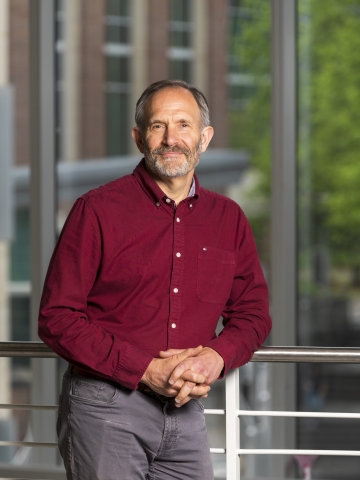Marcus Cicerone
Contact Information
- cicerone@gatech.edu
- Phone
- (404) 894-2761
- Location
- MoSE G026
- Research Group
- Cicerone Group Website
- Publication Links
- Google Scholar

Marcus Cicerone
Professor
Awards
- Arthur S. Flemming Award - 2017
- Fellow of the American Physical Society - 2016,
- The Washington Academy of Sciences Physical & Biological Sciences Award - 2015
- Department of Commerce Bronze Award – 2012
- Department of Commerce Bronze Award - 2008
- J&J Corporate Office of Research Directors Research Fellowship - 1998
- IBM Polymer Science & Technology Predoctoral Fellow - 1993
- Department of Education Predoctoral Fellow - 1992
- Pergamon/Spectrochimica Acta Atomic Spectroscopy Award - Honorable Mention - 1989
Education
- Ph.D., 1994, University of Wisconsin, Madison
- B.S., 1989, Brigham Young University
Research
We use light, neutrons, and molecular dynamics simulation to probe intramolecular and intermolecular motion on timescales ranging from MHz to PHz. These studies inform us about complex interactions between molecules and within molecular systems that underly macroscopic behaviors as disparate as materials properties and biological function.
Intra-molecular vibrations provide unique spectral “barcodes” for chemical substances. My group and I introduced broadband coherent anti-Stokes Raman scattering (BCARS) microscopy in 2004, which uses nonlinear light-matter interactions to rapidly read these spectra and generate sub-micron resolved images containing full Raman vibrational spectra at each pixel. We continue to improved BCARS imaging speed and sensitivity. Our current pixel acquisition time is a few milliseconds, providing an imaging speed that is conducive to practical materials and biological applications, and our work was recognized in 2014 as as one of the top 10 innovations in BioPhotonics. The goals in this project focus on instrument development and scientific discovery. Instrument development opportunities include innovations in ultrafast, nonlinear optics and computation (we envision microsecond spectral acquisition, requiring data processing and analysis at Gb/s rates). Opportunities for scientific discovery are wide-ranging. We currently focus on selected mechanistic questions in cancer biology, viral infection, and lipid metabolism, and on developing approaches for characterizing cell culture and biopharmaceutical formulation.
Microscopic inter-molecular motions underly many macroscopic properties of liquids and solids. We use light scattering, neutron scattering, and molecular dynamics simulation to characterize these motions in pursuit of a clear, molecularly-based understanding of how they ultimately lead to relaxation and transport in amorphous systems (liquids and glasses). We have shown that liquid dynamics on a 1 picosecond timescale are composed of two distinct types of motion. This finding has allowed us to derive simple expressions for molecular transport in liquids and amorphous solids based on easily measured or simulated picosecond dynamic quantities. As we develop these insights, they will help materials scientists to reliably perform bottom-up design of novel materials with targeted transport and relaxation properties. Opportunities on this project include development of novel approaches to characterize these picosecond motions, refining and testing our ideas about liquid dynamics, and applying these ideas to solve problems in areas such as ionic liquids for battery applications, performance of drug eluting stents, and stabilizing freeze-dried vaccines and therapeutic proteins for use in developing nations.